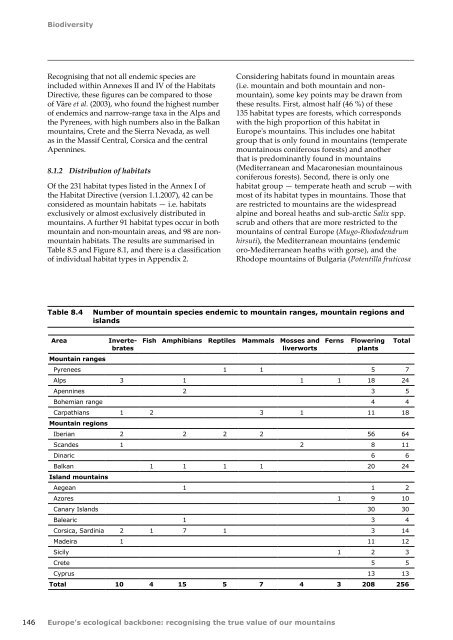Europes ecological backbone.pdf
Europes ecological backbone.pdf
Europes ecological backbone.pdf
You also want an ePaper? Increase the reach of your titles
YUMPU automatically turns print PDFs into web optimized ePapers that Google loves.
Biodiversity<br />
Recognising that not all endemic species are<br />
included within Annexes II and IV of the Habitats<br />
Directive, these figures can be compared to those<br />
of Väre et al. (2003), who found the highest number<br />
of endemics and narrow-range taxa in the Alps and<br />
the Pyrenees, with high numbers also in the Balkan<br />
mountains, Crete and the Sierra Nevada, as well<br />
as in the Massif Central, Corsica and the central<br />
Apennines.<br />
8.1.2 Distribution of habitats<br />
Of the 231 habitat types listed in the Annex I of<br />
the Habitat Directive (version 1.1.2007), 42 can be<br />
considered as mountain habitats — i.e. habitats<br />
exclusively or almost exclusively distributed in<br />
mountains. A further 91 habitat types occur in both<br />
mountain and non-mountain areas, and 98 are nonmountain<br />
habitats. The results are summarised in<br />
Table 8.5 and Figure 8.1, and there is a classification<br />
of individual habitat types in Appendix 2.<br />
Considering habitats found in mountain areas<br />
(i.e. mountain and both mountain and nonmountain),<br />
some key points may be drawn from<br />
these results. First, almost half (46 %) of these<br />
135 habitat types are forests, which corresponds<br />
with the high proportion of this habitat in<br />
Europe's mountains. This includes one habitat<br />
group that is only found in mountains (temperate<br />
mountainous coniferous forests) and another<br />
that is predominantly found in mountains<br />
(Mediterranean and Macaronesian mountainous<br />
coniferous forests). Second, there is only one<br />
habitat group — temperate heath and scrub —with<br />
most of its habitat types in mountains. Those that<br />
are restricted to mountains are the widespread<br />
alpine and boreal heaths and sub-arctic Salix spp.<br />
scrub and others that are more restricted to the<br />
mountains of central Europe (Mugo-Rhododendrum<br />
hirsuti), the Mediterranean mountains (endemic<br />
oro‐Mediterranean heaths with gorse), and the<br />
Rhodope mountains of Bulgaria (Potentilla fruticosa<br />
Table 8.4<br />
Number of mountain species endemic to mountain ranges, mountain regions and<br />
islands<br />
Area<br />
Invertebrates<br />
Mountain ranges<br />
Fish Amphibians Reptiles Mammals Mosses and<br />
liverworts<br />
Ferns<br />
Flowering<br />
plants<br />
Pyrenees 1 1 5 7<br />
Alps 3 1 1 1 18 24<br />
Apennines 2 3 5<br />
Bohemian range 4 4<br />
Carpathians 1 2 3 1 11 18<br />
Mountain regions<br />
Iberian 2 2 2 2 56 64<br />
Scandes 1 2 8 11<br />
Dinaric 6 6<br />
Balkan 1 1 1 1 20 24<br />
Island mountains<br />
Aegean 1 1 2<br />
Azores 1 9 10<br />
Canary Islands 30 30<br />
Balearic 1 3 4<br />
Corsica, Sardinia 2 1 7 1 3 14<br />
Madeira 1 11 12<br />
Sicily 1 2 3<br />
Crete 5 5<br />
Cyprus 13 13<br />
Total 10 4 15 5 7 4 3 208 256<br />
Total<br />
146 Europe's <strong>ecological</strong> <strong>backbone</strong>: recognising the true value of our mountains

















